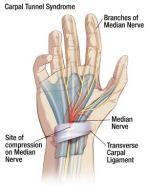- Home
- CTS surgery
- Carpal Tunnel Surgery Complications
Carpal tunnel surgery complications
What are the carpal tunnel surgery complications you need to know about?
FIRST OF ALL, complications in general are infrequent, ranging from less than 1% to 5%.
The success rate in relieving Carpal tunnel symptoms is around 88%-90%..in cases of correctly diagnosed carpal tunnel syndrome (CTS).
HOWEVER, as with any surgical procedure complications can occur. The most common ones involve Anesthesia, Infections, Incision pain, Persistent symptoms, Cutting the median nerve, Incomplete ligament release, and Hand weakness.
Anesthesia
Problems arise sometimes between the anesthesia medicine and drugs a patient is already taking. In rare cases, a patient may have problems with the anesthesia itself. Be sure to discuss ALL your medicines and the risks and any other concerns you have with your anesthesiologist. I recommend that while at home you write down your questions on an index card, and bring that with you so you don't forget your questions the day of the surgery.
Infection
Infection of the incision(s) is possible after any surgery. So check your incision daily if instructed to. If you think you have a FEVER, check your temperature.
These things can be warning signs of infection:
- Pain in your hand or wrist that IS NOT relieved by your pain medicine
- Drainage of fluid or pus with an unpleasant odor coming from the incision
- Swelling,heat,and redness along your incision
- Fever or chills over 100.5 degress
- Bright red blood coming from your incision
Incision pain
Falls under carpal tunnel surgery complications in that some patients report having pain along the palm incision. Studies have shown and it's been my experience as well, that the Open Procedure does cause more pain and swelling than the Endoscopic Procedure.
Sometimes patients still feel numbness and tingling after surgery, especially if they had severe pressure on the median nerve prior to surgery.
When the Thenar (Thean-are) or thumb muscle is notably shrunken from prolonged pressure on the median nerve, strength and sensation may not fully return even after surgery. See RECOVERY FROM CARPAL TUNNEL SURGERY.
Carpal tunnel surgery complications are rare but you do need to discuss them with your surgeon.
Persistent symptoms
There is a chance that problems or symptoms of carpal tunnel syndrome won't go away completely. Sometimes it can go away but then reoccur later. This is rare, but is more likely to happen in workers who go back to a job or a hobby where they hold on to vibrating tools for long hours or perform highly repetitive tasks.
Cutting the median nerve
This is a rare overall, of carpal tunnel surgery complications but may happen more often with the endoscopic procedures vs the open procedures but since the mid 90's this complication has decreased as more and more surgeons gain exoerience and skill with the endoscopic procedures. Sometimes the nerve is "nicked" which may cause some milder but persistent symptoms as well.
Incomplete ligament release
This is one of the carpal tunnel surgery complications. Again, this is seen more often with endoscopic procedures than open procedures due to the limited amount of space within your wrist and the surgeon is trying to visualize all the different structures through a hole the size of a ball point pen. The camera does magnify the images and it is viewed on a TV screen, but there is just not a lot of room in there!
Sometimes it is difficult to completely visulaize the transverse ligament, so an incomplete cut or release can occur. If this happens symptoms may not go away completely. Some patients end up needing a second surgery to completely release the carpal ligament. See ANATOMY OF THE CARPAL TUNNEL.
Hand weakness
Your hand and grip strength are going to seem weak after the surgery, and this is normal. You need to follow your surgeon's order as to how much you can use your wrist and hands. You may be prescribed some physical therapy or you may just be given some putty or hand exercises to do at home.
Either way MOST PATIENTS will notice gradual improvements every week and should achieve maximum hand strength within 3-6 months. Those with severe atrophy (At-trophy) a shrunken, weak muscle, they will see improvements in hand strength,but they usually don't regain normal muscle tone and strength in the thumb and hand.
Carpal tunnel surgery complications are rare but you do need to discuss them with your surgeon.
CTS Explanation
Carpal tunnel syndrome causes
CTS Wrist Braces
- Home
- CTS surgery
- Carpal Tunnel Surgery Complications
Share this page:
Recent Articles
-
The carpal tunnel store
The carpal tunnel store has a huge selection of Medical Grade Products -
Anatomy of the carpal tunnel
The carpal tunnel anatomy is easy to understand if you remember we're dealing with a tunnel of sorts in your wrist. Learn the anatomy from a medical practitioner. -
Carpal tunnel prevention program
A carpal tunnel prevention program at the workplace may help employees from getting symptoms. Learn the best carpal tunnel prevention program on the web today.
Recent Articles
-
The carpal tunnel store
The carpal tunnel store has a huge selection of Medical Grade Products -
Anatomy of the carpal tunnel
The carpal tunnel anatomy is easy to understand if you remember we're dealing with a tunnel of sorts in your wrist. Learn the anatomy from a medical practitioner. -
Carpal tunnel prevention program
A carpal tunnel prevention program at the workplace may help employees from getting symptoms. Learn the best carpal tunnel prevention program on the web today.
